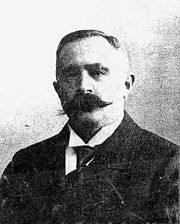
Abraham Buschke
Encyclopedia

Germans
The Germans are a Germanic ethnic group native to Central Europe. The English term Germans has referred to the German-speaking population of the Holy Roman Empire since the Late Middle Ages....
dermatologist who was a native of Nakel in the Province of Posen
Province of Posen
The Province of Posen was a province of Prussia from 1848–1918 and as such part of the German Empire from 1871 to 1918. The area was about 29,000 km2....
. In 1891 he received his doctorate in Berlin
Berlin
Berlin is the capital city of Germany and is one of the 16 states of Germany. With a population of 3.45 million people, Berlin is Germany's largest city. It is the second most populous city proper and the seventh most populous urban area in the European Union...
, and afterwards was a surgical
Surgery
Surgery is an ancient medical specialty that uses operative manual and instrumental techniques on a patient to investigate and/or treat a pathological condition such as disease or injury, or to help improve bodily function or appearance.An act of performing surgery may be called a surgical...
assistant in Greifswald
Greifswald
Greifswald , officially, the University and Hanseatic City of Greifswald is a town in northeastern Germany. It is situated in the state of Mecklenburg-Vorpommern, at an equal distance of about from Germany's two largest cities, Berlin and Hamburg. The town borders the Baltic Sea, and is crossed...
. Later he worked at dermatological clinics in Breslau under Albert Neisser (1855-1916) and in Berlin with Edmund Lesser
Edmund Lesser
Edmund Lesser was a German dermatologist who was a native of Neisse.He studied medicine at the Universities of Berlin, Bonn and Strasbourg, and in 1876 earned his medical doctorate. Later he became an assistant to Oskar Simon at the dermatological clinic in Breslau, and in 1882 received his...
(1852-1918). In 1906 he became head of dermatology at the Rudolf-Virchow-Krankenhaus. In 1943 he died in the Nazi concentration camp at Theresienstadt, Bohemia
Bohemia
Bohemia is a historical region in central Europe, occupying the western two-thirds of the traditional Czech Lands. It is located in the contemporary Czech Republic with its capital in Prague...
.
Abraham Buschke specialized in research of venereal disease. In 1926 with Martin Gumpert
Martin Gumpert
Martin Gumpert was a Jewish German-born American physician and writer.In 1936, he went to America. In 1942, he became a US citizen. Gumpert provided the German author Thomas Mann with information about the course of the disease of syphilis...
(1897-1955) he published a treatise on syphilis
Syphilis
Syphilis is a sexually transmitted infection caused by the spirochete bacterium Treponema pallidum subspecies pallidum. The primary route of transmission is through sexual contact; however, it may also be transmitted from mother to fetus during pregnancy or at birth, resulting in congenital syphilis...
in children titled Geschlechtskrankheiten bei Kindern. His name is associated with several eponymous dermatological disorders, including:
- Buschke's scleredemaScleredemaScleredema, also known as Buschke disease, Scleredema of Buschke, and Scleredema adultorum, is a rare, self-limiting, skin condition defined by progressive thickening and hardening of the skin, usually on the areas of the upper back, neck, shoulders and face. The skin may also change color to red...
: Hardening and thickening of the skin, usually on the upper back, neck, shoulders and face. Its etiologyEtiologyEtiology is the study of causation, or origination. The word is derived from the Greek , aitiologia, "giving a reason for" ....
is unknown, but it is often associated with diabetes. - Buschke-Löwenstein tumor: Also known as giant condylomaCondylomaCondyloma refers to an infection of the genitals. The two subtypes are:* Condyloma acuminata, or genital warts, caused by human papilloma virus subtypes 6, 11, and others...
acuminatum; a variety of venereal wart characterized by its large, cauliflower-like appearance. Named with Dr. Ludwig Loewenstein (1885-1959). - Buschke-Ollendorff syndromeBuschke-Ollendorff syndromeBuschke–Ollendorff syndrome, also known as Dermatofibrosis lenticularis disseminata, is a rare genetic disorder associated with LEMD3. It is believed to be inherited in an autosomal dominant manner....
: Also called disseminated lenticular dermatofibrosis. Named with dermatologist Helene Ollendorff Curth.
In 1894 with pathologist Otto Busse
Otto Busse
Otto Emil Franz Ulrich Busse was a German pathologist. Busse was born in Belgard, Pomerania, Prussia and studied medicine at the University of Greifswald, and subsequently became an assistant to Paul Grawitz , at Greifswald...
(1867-1922), Buschke described an infectious disease caused by the fungus
Fungus
A fungus is a member of a large group of eukaryotic organisms that includes microorganisms such as yeasts and molds , as well as the more familiar mushrooms. These organisms are classified as a kingdom, Fungi, which is separate from plants, animals, and bacteria...
Cryptococcus neoformans
Cryptococcus neoformans
Cryptococcus neoformans is an encapsulated yeast that can live in both plants and animals. Its teleomorph is Filobasidiella neoformans, a filamentous fungus belonging to the class Tremellomycetes. It is often found in pigeon excrement....
. This condition is sometimes referred to as Busse-Buschke disease.

